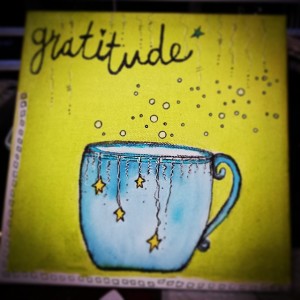~ * ~
This article is written by Ann Strecko Koeman
As an artist I am often asked “where do you get your ideas?”. I usually smile and politely reply “all around me”. To the non-artist this seems like a flakey answer, or that I don’t wan’t to share some secret and mysterious portal of inspiration that only artist types have access to. In other words I feel like Hermione in the Harry Potter series of books, who has magical powers but must live within the mogul world! However, as lame as my answer sounds it is the truth. Creatives get their inspiration everywhere, and anywhere. Inspiration strikes when you are living, working, playing, and even sleeping.
Personally I find that I get ideas all the time just by living and acting. If I am ill or depressed and not moving I do not feel the same level of inspiration as when I am well but I still am open to any ideas. Which is why I try to always have pen and paper near by to jot down any ideas I get. As some of you are reading this you may be thinking “now, really, where do you get your inspiration?”. For you, I am including a list of inspirational starting points.
From my every day life and interactions with my family.
A song playing on the radio.
Something I overheard while eating out at the restaurant.
Seeing children playing outside.
The woods behind my house.
Flipping through catalogs and magazines
Tossing the junk mail into the recycling bin.
While watching a movie.
Surfing the internet, browsing through websites, Pinterest etc.
Looking through my vast collection of books (not just the art ones)
Cleaning around my house (ok I don’t do that very often)
Talking with other creative people.
Talking with my husband (get it, he’s not creative or so he says).
Purging a closet.
While shopping (favourite one).
Walking around my neighbourhood.
Chatting with my neighbours.
Reading old magazines while waiting at the Doctor’s office.
Doodling while waiting at the Doctor’s office.
Checking out all the new products for pets in the shop while waiting for our cat to be seen by her Vet.
The people waiting in line at the post office.
My drive to and from home.
Packaging.
Artwork by other artists.
How- to leaflets in the department stores, and craft stores.
The hardware store.
Shovelling snow.
Waiting for my car to warm up in winter and cursing at the ice I have to chip off the windshield.
The new design on the paper coffee cup I just bought from the drive thru to warm up my frozen fingers from doing the previous.
My garden, any time of year.
The wildlife and the neighbour’s pets.
Taking a class.
Writing a blog post.
Attending a trade show.
The thrift store.
Whatever it is that I am doing I stay open to any ideas that come my way. There are days where I get a bunch of ideas that amount to nothing. On the other hand sometimes a simple thought will develop itself into a larger idea and snowball into a project. On the days that I just feel void of any creativity I just start doing anything, I doodle, splash some ink on a surface, rearrange my basket of scraps, or pull out an all in one beginner’s crafting kit just to get me going. My best days are when I am overflowing with ideas and I just scribble them all down like a mad woman into my many notebooks for fear I will forget them. I also take photos often of anything that inspires me if I don’t have that pen and paper or can’t put into words the idea I just got.
So, I could list so many more ways to find inspiration but I think I have made my point. Look around with an open mind and listen, there just might be the next big inspiration whispering to you.
~*~*~*~*~*~*~*~*~*~*~*~*~*~*~*~*~*~*~*~*~*~*~*~*~
Ann is the Artist and owner behind Annmakes®, a blog about Mixed Media Arts and Crafting in general. She is based in Canada just outside the nation’s capital of Ottawa, Ontario. As the winters are long and cold there, she is bunkered down in her studio/office with a mug of coffee in the morning and a mug of tea in the afternoon, and wishes she did not have to leave until the Spring thaw!
~*~*~*~*~*~*~*~*~*~*~*~*~*~*~*~*~*~*~*~*~*~*~*~*~
.
.













Recent Comments